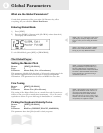
7
Editing Programs
34
The following diagram shows the signal flow for each Sound:
Modulation
In synthesizer programming, modulation refers to modifying some
aspect of a sound over time. Modulation is the key to making rich and
expressive sounds. The vibrato of a flute, the expression pedal of an
organ, and the wah pedal on a guitar are all examples of modulation.
Modulation can be used to control basic characteristics of a voice,
including pitch, filter frequency, volume, and envelope.
With some parameters, the modulation amount can be positive or
negative. With positive modulation for example, keyboard velocity can be
used to make a Sound brighter the harder you play. This is how many
acoustic instruments behave. With negative modulation, you also have
the ability to make the Sound more muted the harder you play. Setting
modulation to 00 turns off the modulation source.
LFO (Low Frequency Oscillator)
The term LFO stands for “Low Frequency Oscillator”. The LFO creates
a cyclic waveform that varies over time with a specified shape and speed.
This waveform can be used as a modulation source. The pitch, filter, and
amp modules each have a dedicated LFO.
Envelopes
An envelope is a modulation source that varies over time, starting from
when you strike a key. There are three independent envelope generators
(for pitch, filter, and amplitude) in each Sound layer.
NOTE: Modulation cannot force a
parameter beyond its maximum or minimum
value. For example, if the Amp is set to its
minimum value, applying negative
modulation will not affect it.
Voice Filter Amp
Envelope
Envelope
Envelope
LFO
LFO
LFO
Pan
Effects Sends
Range
Sound 1
Sound 2
Sound 3
Sound 4


















